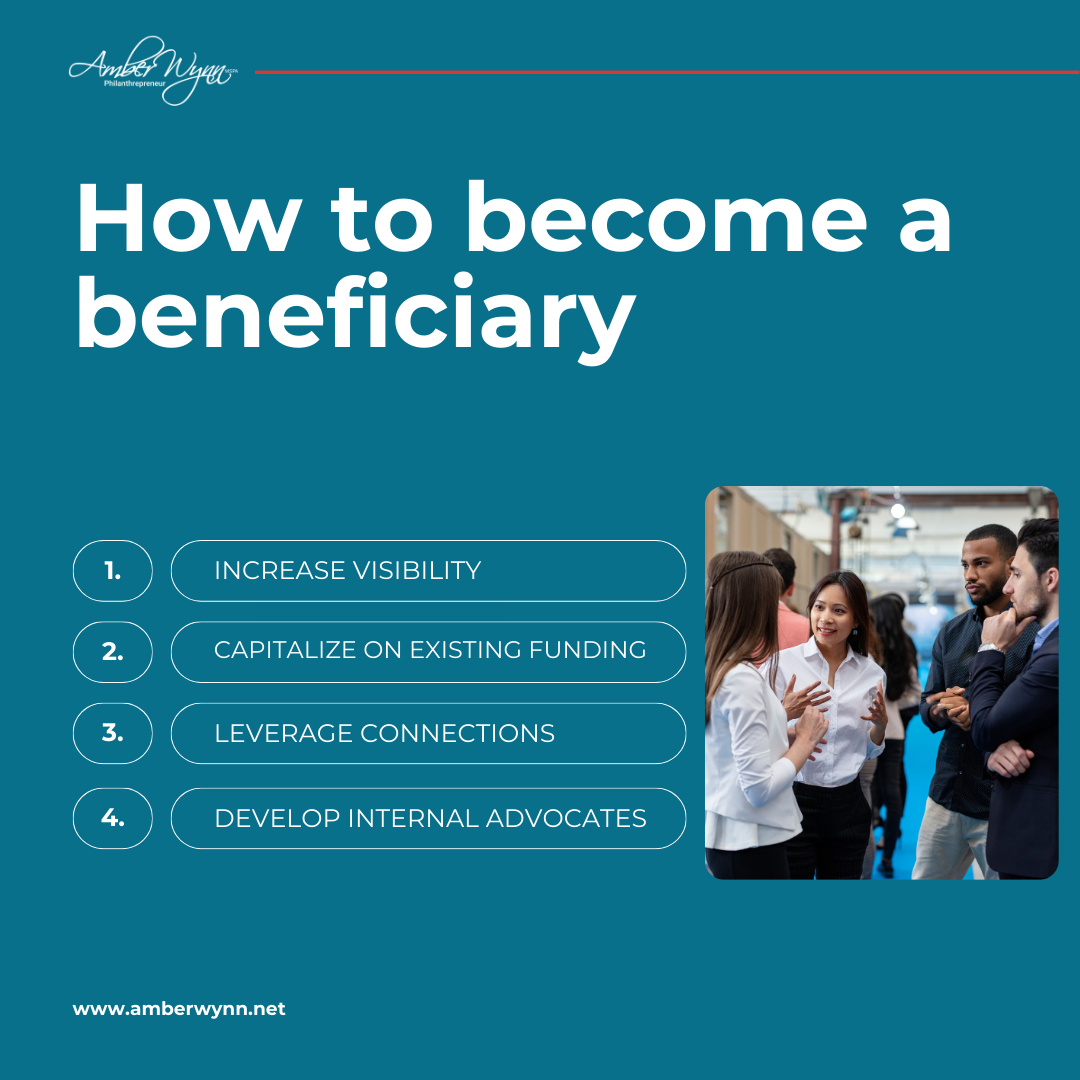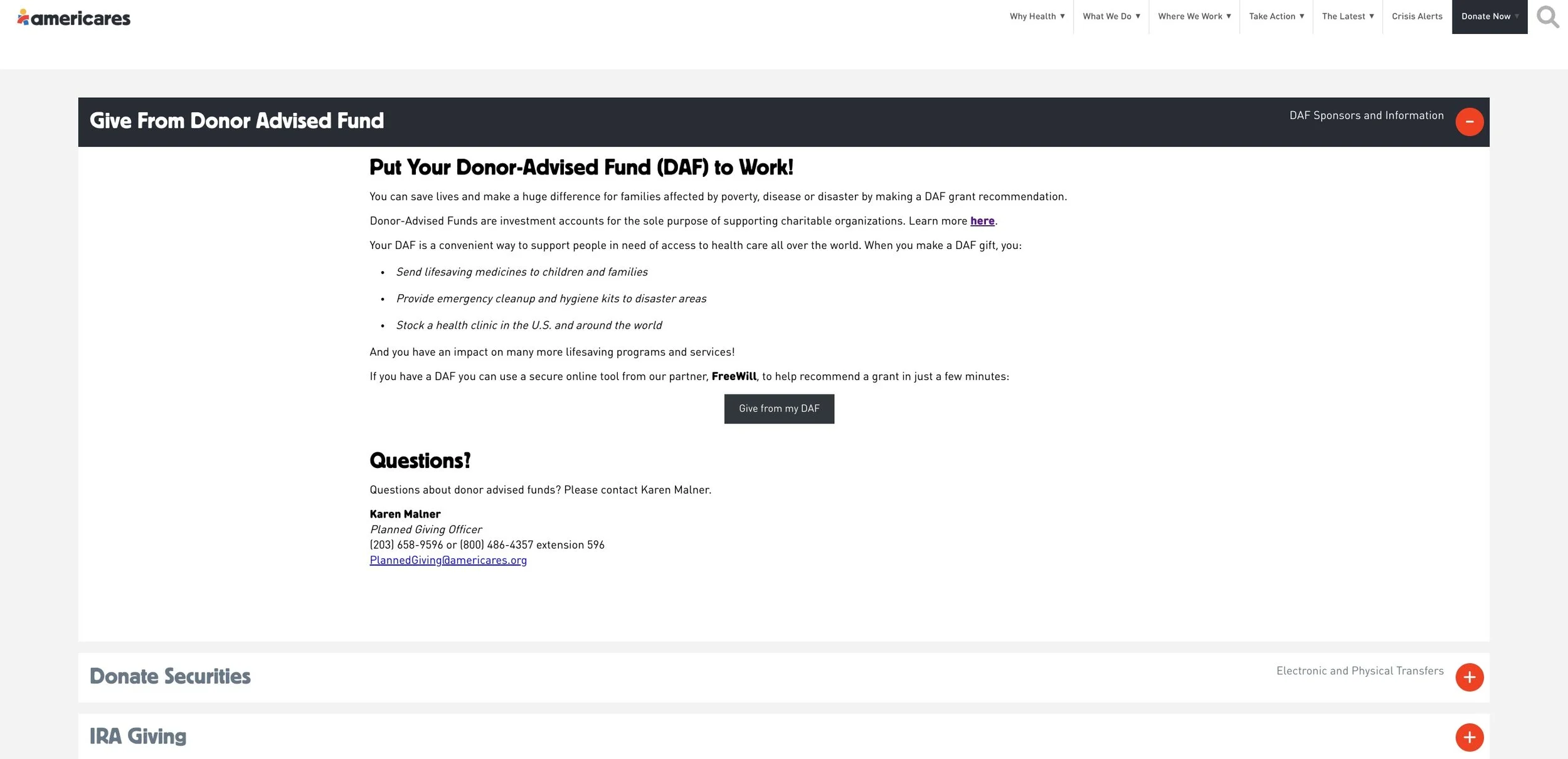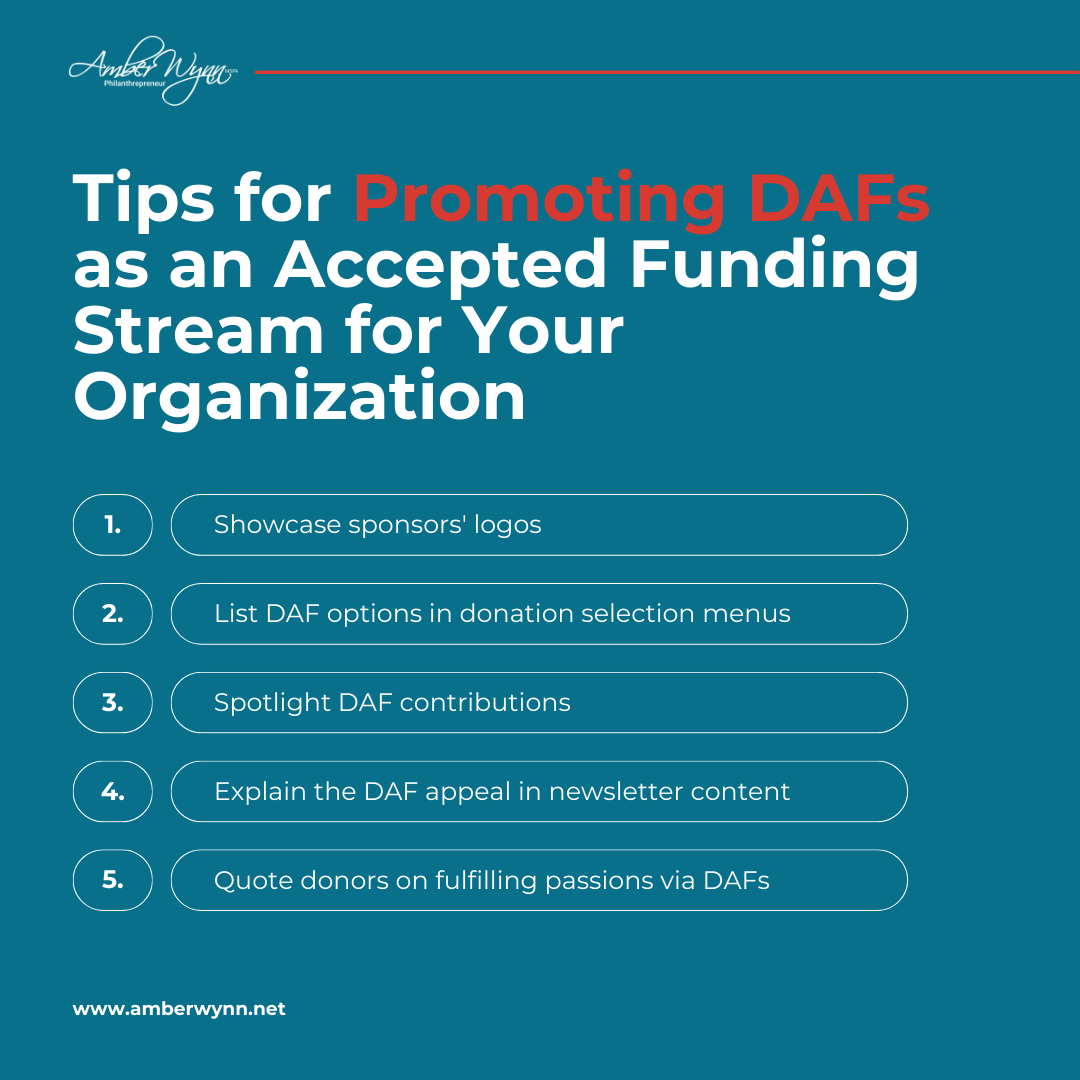What Are Donor-Advised Funds (and How to Make Them a Part of Your Diversified Funding Streams)?
Among the challenges nonprofits face, having adequate funding is at the top of the list. According to a 2023 study, 76% of nonprofits have experienced stagnant or decreased funding over the last year! So, despite constantly running around finding ways to bring in money—including looking for donors and submitting grants—there is a need for nonprofit organizations to identify new streams of revenue.
If you’re thinking somewhere along the lines of “Tell me about it,” then you understand why I always say, “A nonprofit should have at least 10 streams of revenue.”
This ensures that you are not dependent on one or two sources of funding. If one stream dries up, you still have (at least) nine to enable you to keep your programs going and pay for overhead costs.
This article talks about a funding source you should consider adding to your revenue stream: Donor-Advised Funds (DAFs).
Table of Contents
What Are Donor-Advised Funds?
How do Donor-Advised Funds work?
Pros and Cons of Donor Advised Funds
How to Access Donor-Advised Funds
Who manages donor-advised funds?
How to become a beneficiary
How to Add Donor-Advised Funds to Your Nonprofit’s Streams of Revenue
Tips for Promoting DAFs as an Accepted Funding Stream for Your Organization
Add Donor-Advised Funds to Your Streams of Revenue
FAQ
What Are Donor-Advised Funds?
DAFs are used by high-net-worth individuals to administer their philanthropy. Donor-Advised Funds (also called donor advised funds and DAFs) are charitable giving accounts that allow individuals to make contributions to a fund, receive an immediate tax deduction, and recommend grants from the fund to nonprofit organizations over time. DAFs are required by law to give away 5% annually.
While community foundations pioneered them nearly 100 years ago, today, DAFs have exploded in variety. Major sponsors now include national charities, financial institutions, faith-based foundations, and single-issue charities across causes. Universities, hospitals, museums, and more also host DAFs aligned to their missions.
DAFs are popular with wealthy individuals and family foundations—notable names include Elon Musk, Larry Page, Mark Zuckerberg, and MacKenzie Scott. However, they now also appear in workplace giving platforms, crowdfunding campaigns, and other democratizing models that expand access. This enables donation pooling from multiple contributors with grants suggested to donees they collectively support.
In essence, DAFs allow account holders to customize ongoing impact through a sponsor. Grant recipients range from local community programs to global NGOs. Regardless of the cause, DAFs facilitate large-scale generosity.
How do Donor-Advised Funds work?
Donor-Advised Funds (DAFs) revolutionize charitable giving with a structured process that empowers donors while supporting nonprofits.
Donor contribution: The donor initiates the process by funding the DAF account instead of starting a nonprofit organization. Funds are distributed to charitable organizations from the DAF.
Recommendation authority: DAF donors enjoy the unique ability to recommend how the assets within the fund should be invested, allowing them to actively participate in shaping the financial strategy and specify where the donations should go—without the expense and hassle of running a nonprofit organization that requires staff, overhead, etc.
Sponsoring organization management: The sponsoring organization, often a community foundation or financial institution, takes charge of managing the DAF. This involves overseeing investments, handling administrative tasks, and ensuring compliance with regulations.
Charitable distributions: Acting upon the donor's recommendations, the DAF efficiently distributes the earmarked funds to selected charitable organizations. This streamlined process provides a flexible and tax-efficient way for donors to support causes they care about.
Pros and Cons of Donor Advised Funds
As with every stream of revenue, DAFs have advantages and disadvantages. Let’s look at these in detail.
Pros of donor advised funds
1. Additional revenue stream
DAFs have transformed into major drivers of charitable giving. With over 1 million donor advised fund accounts in the U.S. and over $160 billion in assets, they represent a rapidly increasing pool of philanthropic capital for nonprofits to obtain grants from. As DAF sponsors actively recommend and efficiently facilitate grants to grantee organizations, being on sponsors' radar opens nonprofits up to new donor networks.
2. Less operational effort
Reduced administrative burden for donors. Donors can avoid the time-consuming and potentially costly tasks of managing their own charitable foundation, such as legal filings, record-keeping, and grant administration. The fund handles these operational aspects, allowing donors to focus solely on their philanthropic goals.
3. Recurring support
The flexibility of DAF accounts enables donors to recommend repeat grants to their favorite charitable causes year after year. This provides reliable income streams for nonprofits and causes that donors actively sponsor through their fund.
Cons of donor advised funds
1. No guarantees on timing or amount
While a nonprofit may receive indications that a DAF grant is forthcoming, sponsors make the ultimate grant approval. Even with a donor’s recommendation, factors like available account balances, grant minimums, etc., mean donations aren't guaranteed. This can pose cash flow issues for nonprofits budgeting around expected DAF grants. This brings us back to…have at least 10 streams of revenue.
2. Less direct donor relationships/communication
DAF sponsors stand between donors and the nonprofits receiving grants. This intermediary role means nonprofits often have fewer opportunities to directly build relationships and communicate impact to the donors funding their work.
3. Dependency risks if cut off
Reliant nonprofits face financial issues if they lose repeat, major DAF funding for a program as recommenders shift giving elsewhere. Contingency budgets help, but replacing large gifts still presents a challenge. At the risk of sounding like a broken record…
How to Access Donor-Advised Funds
Now that you know what donor-advised funds are and how they can benefit your nonprofit, it’s time to understand how you can access DAFs.
Who manages donor-advised funds?
Donor-advised funds reside at a variety of charitable sponsor organizations that manage the accounts and facilitate grant-making. The major types of DAF sponsors include:
Community foundations: Place-based public charities that house multiple donor funds (including DAFs) focused on improving a defined geographic region from a city to multi-county area. There are over 800 community foundations across the U.S.
National charitable sponsors: Large nonprofits like United Way Worldwide, American Endowment Foundation, National Philanthropic Trust, etc. that offer DAFs, pooled funds, and other giving options tailored to varied causes on a national scale.
Wealth management firms: Banks, wealth advisory firms, investment companies, and other financial service providers increasingly offer philanthropic DAF accounts for clients as part of holistic wealth planning. Examples are Fidelity Charitable, Goldman Sachs Philanthropy Fund, and JP Morgan Charitable Giving Fund.
Faith-based foundations: Religious institutions like the Lutheran Foundation, National Christian Foundation, and Jewish Federations host DAFs aligned to faith-based missions regionally and nationwide.
Understanding this landscape of the major DAF sponsor categories and becoming familiar with options in your area is key. This knowledge allows nonprofits to strategically focus their visibility efforts on the most relevant decision-makers overseeing funds.
How to become a beneficiary
There are some key factors that will boost your chances of becoming a beneficiary of Donor-Advised Funds.
1. Increase Visibility
Showcase your impact through newsletters, website content, annual reports, and podcast interviews. Quantify your mission results. More so, promote recent award wins, compelling initiatives, and major announcements via platforms sponsors follow.
Americare’s “Ways to Give” page is an excellent example of increasing visibility.
They even have a specific section highlighting DAFs and how their supporters can make a DAF grant recommendation. Make it easy for your donors!
2. Capitalize on existing funding
Funders tend to fund organizations already funded. The nonprofit world is a small community. Funders talk to each other so if you have a good track record, then funders will recommend you.
3. Leverage existing connections
This is why having seasoned board members is important. They know wealth managers (or they can be wealth managers!), and they sit on other boards. They have connections.
4. Develop internal advocates
Cultivate relationships with program officers at community foundations. Get to know the officer over your area of focus. If they know and like you, your nonprofit can become their recommended grantee for applicable DAFs.
Reach out to wealth managers, communicate your outcomes to them to convey client fit, and build relationships as well. The more known your tangible community impact is, the higher the likelihood of donor funds flowing your way.
How to Add Donor-Advised Funds to Your Nonprofit’s Streams of Revenue
DAFs present a growth opportunity. With the right strategy, your nonprofit can take advantage of it and add another regular source of revenue.
1. Add DAFs to your Fund Development Plan
“Plan” is the key word. If you want your nonprofit to be sustainable, you need to have a Fund Development Plan. This is where you start when branching out and adding DAFs to your revenue stream.
First, conduct landscape analysis to qualify DAF prospects in your area—community foundations, wealth managers, faith-based funds, etc. Understand their focus areas and grant history to estimate realistic projections
Forecast annual income from DAFs in your development plan, increasing in line with relationships built. Set specific targets for acquiring first-time grants from new sponsors annually, as well as repeat fund growth from existing DAF partners.
Read this article for a more in-depth discussion: The Fund Development Plan: The Roadmap For Consistent, Long-Term, Sustainable Nonprofit Funding.
2. Identify a lead person in your organization
Nonprofits need specialists to unlock the potential of donor-advised funds. Unlike regular donations, DAFs involve diverse sponsors, complex decisions, and relationship-based giving. A dedicated DAF liaison can manage this complexity by:
✅ Knowing the players and maintaining a detailed database of sponsors and their interests
✅ Building relationships, including coordinating visits and showcasing your impact
✅ Informing decisions by providing data and insights for grant-making
✅ Engaging sponsors by sharing updates and successes
✅ Managing the grant cycle through guiding applications and reporting outcomes
✅ Tracking progress, including setting goals for funds raised, new sponsors, and repeat grants
This focused approach translates to more effective grant applications, stronger relationships, and, ultimately, more funding for your organization.
3. Add ways to accept DAF contributions on donor-facing materials
Actively invite DAF contributions and let your donors know that this is an option. Here are some ways you can implement this:
Website donation pages
List "Donor Advised Fund" alongside other options like "Credit Card, PayPal" in the payment method dropdown menu. Explain DAFs benefit donors through easy recommendations and tax savings. Americares does this well.
Online donation forms
Expand the gift dedication text to "This gift was recommended via my donor-advised fund through XYZ Sponsor."
Newsletter appeals
Include "Gifts from donor-advised funds welcomed!" and feature sponsor logos. Link to your donation page as well.
Essentially, you should proactively prompt DAF giving by addressing terminology, explaining relevance, and showing processing readiness across channels. This facilitates sponsor grant-making to your mission.
Tips for Promoting DAFs as an Accepted Funding Stream for Your Organization
Here are some tips for promoting DAFs as an accepted funding stream.
Showcase sponsors' logos. For example, feature Fidelity Charitable, Vanguard Charitable, or community foundations that have granted funding.
List DAF options in donation selection menus. You can use a dropdown menu with "Credit Card - PayPal - Donor Advised Fund" payment options.
Spotlight DAF contributions on your website, newsletters, and other collateral. For example, “Recent supporters include Harrington Donor Advised Fund at Silicon Valley Community Foundation.”
Explain the DAF appeal in newsletter content. Something as simple as “DAFs provide a convenient way for donors to give back over time while receiving immediate tax benefits” works.
Quote donors on fulfilling passions via DAFs—much like a testimonial: “The Acadia Family Fund allows us to easily recommend grants to organizations like this close to our hearts.”
Add Donor-Advised Funds to Your Streams of Revenue
Donor-Advised Funds (DAFs) present a promising prospect for nonprofit organizations seeking to diversify funding streams. The benefits of recurring donations, reduced fundraising pressure, and access to new donor networks make DAFs worth exploring.
By strategically aligning your mission with sponsors, showcasing your impact, and actively promoting DAF giving, your nonprofit can tap into this growing pool of philanthropic capital and fuel your journey toward a more sustainable future. Remember, diversification is key—strive for "at least 10 streams of income" to ensure your programs continue to thrive and make a positive impact on your community.
Check out this resource to help build a sustainable nonprofit: How Nonprofits Can Use Podcasts in Their Sustainability Strategy.
If your nonprofit is at the beginning stages, or you are unsure where it stands, I highly recommend my podcast series on the Nonprofit Success Path: The 7 Stages of Building a Successful Nonprofit. It guides you through the process from start to finish.
FAQ
1. How significant is the impact of Donor-Advised Funds (DAFs) on charitable giving?
In 2021, $45.76 billion was granted from DAFs, constituting 9.4% of all charitable giving. The value of DAF grants has seen a remarkable 5x growth over the past decade. As of 2021, there are 1.28 million DAF accounts, marking a substantial 27.6% increase from 2020. Interestingly, it is noted that there are approximately $234 billion in DAF assets that are currently underutilized.
2. What assets can be contributed to a donor-advised fund?
DAFs accept various assets, including cash for immediate grant recommendations, appreciated stocks with potential tax benefits, real estate contributions for charitable support, and even private business interests or cryptocurrency.
3. What are popular DAFs?
Some popular Donor-Advised Funds (DAFs) include Fidelity Charitable, Vanguard Charitable, Schwab Charitable, National Philanthropic Trust, and American Endowment Foundation. These organizations offer diverse options for donors to manage and distribute their charitable contributions.
4. How much money can a donor distribute annually from their DAF account?
While sponsors set their own policies, most allow at least 50% of the fund’s previous year’s ending balance to be granted annually. However, donors can carry remaining balances forward if they don’t max out their distribution for tax efficiency.







